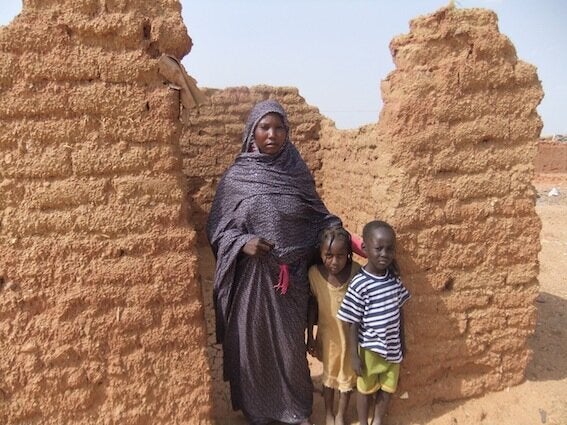
Dahabbaya Idris and her two young children share a single room in her mother's home in Al-Hilla Al-Jadeeda, a suburb of Omdurman, Sudan. Just a few houses down lies the rubble that was once her home, a mud house which completely disintegrated under the force of the heavy rains that have plagued Sudan over the last month. Once a maze of closely-built mud homes, Dahabbaya's neighbourhood now lies ruins, battered by the violent winds and rain.
'We've had to move into my mother's house," she says. "But most of it has collapsed as well so we all stay in the only room still habitable.'
Dahabbaya's story reflects the reality of over half a million Sudanese people devastated by this year's especially turbulent rainy season. According to the World Health Organisation (WHO), the storms have taken 53 lives and left 77 people injured. These figures are expected to rise as poor sanitation and increased breeding sites for mosquitos and flies result in widespread diarrhoeal disease and malaria.
At the fore-front of emergency aid efforts is Nafeer, a youth-led initiative aimed at providing relief against the effects of rains and flooding. The group began in direct response to the catastrophic storms of early August. And what was initially a simple Facebook message thread between twenty or so friends expanded into a network of hundreds of experts and volunteers working together to provide assistance to victims of the crisis.
'When it opened as an official Facebook Page it was called Nafeer. The idea behind the name was the "Nafeer" of Sudan, a collective community response to crisis and strife. A special tradition in Sudanese culture.' says Moiz Abdelrahman, a Nafeer committee member.
To date, the initiative has gathered nearly 100,000 US dollars in donations from the Sudanese diaspora all over the world, using the money to distribute supplies, provide clinical assistance and build flood barriers, among other emergency measures. The complaint system used to assess and allocate help to damaged areas has been under constant development since the group's creation. Just over a month old, it is constantly evolving through day to day feedback.
I met Dahabbaya and her aunt outside the Nafeer headquarters in Khartoum where she had travelled to file a complaint on behalf of her neighbourhood. She had heard about the initiative through a distant relative and having lost faith in her local council, she made the two hour long journey to their offices in hope of getting help.
'No one in my neighbourhood trusts our council. We know that supplies have arrived but none of us have received anything. They [council members] distribute things amongst themselves and we only hear about blankets and mosquito nets but never see them', she says.
After her complaint was filed and volunteers gathered, a team set off to survey her area with her and her aunt in tow. Once volunteers recorded and analysed the state of Dahabbaya's neighbourhood, they then passed on their forms to the head office and the next day a distribution team returned with blankets, mosquito nets and nutrition kits.
In an effort to prevent the collapse of neighbourhoods like Dahabbaya's in future rainy seasons, the government has now enforced a policy banning mud-brick construction. On the tail of this decision, the price of cement rose drastically leaving those already too poor to initially afford concrete housing with very few options when rebuilding their homes. However, the Minister of Environment Hassan Abdelgadir Hilal told me that the government is working to provide cheaper options.
'We will provide compensation and have prohibited the building of mud houses. We now have equipment which makes Stabilised Soil Bricks (SSB) that consist of 95% sand and plaster and only 5% cement. We imported this technology from India and China with help from the UN Habitat, and are offering it free of charge to the governors of each state who will then distribute it to localities,' he says.
While Hilal welcomes the efforts of Nafeer, other government officials have called them 'communists' and 'left-wing' in local press. In the face of such accusations, volunteers say they remain focused on their initial goal of providing aid to the victims of the crisis.
'When you walk through our offices you'll find all the factions, faiths and ethnicities that embody sudanese society," says Abdelrahman.
Under Sudan's strict state order, allegations such as these are taken very seriously. But the communities Nafeer help don't seem to care - greeting volunteers with sweets and tea.
'During the first few visits, we had rocks thrown at us by people who had become very hostile towards outsiders. It took us time to gain their trust.' says Khalil Jafaar, a volunteer team leader at Nafeer.
It may be scant comfort to Dahabbaya, but there is a positive note to Sudan's move away from aridity and drought.
According to Hilal, Sudan is changing into a much wetter climate with the movement of the tropical rain belt northwards towards Aswan in Southern Egypt. This has made arid and semi-arid lands transform into wetlands, causing floods but also bringing prospects of improved food security with 75% of local agriculture being rain-fed.
Nafeer is also hopeful that the unity shown by communities in Sudan during this crisis has established a template for the future.
'Our true goal lies in directing community participation towards facing the real challenges of the crisis to guarantee that recovery will be more systematic in the future', says Abdelrahman.